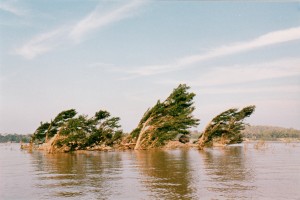[In January 2003 I accompanied an expedition that was conducting a survey of river dolphins on a stretch of the Mekong River in Cambodia. The expedition was led by Isabel Beasley, who was then a PhD student specializing on Orcaella brevirostris: also known as the ‘Irrawaddy Dolphin’ this species is found in many Asian river systems and deltas. The journal I kept during the expedition will appear on this site as a continuous series of posts. This is part 7 of the series.]
April-May is the height of the dry season and in those months the rivers fall. The topography of the river is very scattered here – there are many little islands and outcrops of rock, and also large clumps of bushes. Isabel says that dolphins are often seen in the vicinity of the bushes, possibly because fish breed more plentifully around the bushes and islands.
A short way up from this stretch of river are some rapids. Between here and Stung Treng and the Laos border there are many such rapids, some quite steep. At some times of the year when the river is high, there are navigable channels that skirt the rapids, but at other times of the year the rapids are impassable. Apparently the Chinese have hatched a plan to make the Mekong navigable all year round, so that big container ships will be able to travel much farther up. To do this they will simply blow up the rapids and make the river deeper in those stretches. This had caused great concern for Isabel and others in the conservation community; they think that it will greatly endanger the dolphins and other species. The rapids are close enough to be visible from the pools at Kampi and Chroy Banteay. It is hard to see how explosions so close by could have anything other than a catastrophic effect.


